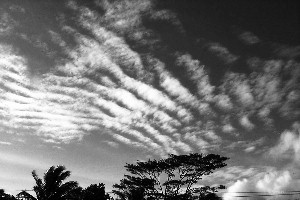SC 202 Weather and Climate Test One Name:
- What is the numerical value of the Environmental Lapse Rate (ELR) in degrees Celsius per
kilometer of rise in altitude?
- If the temperature at sea level is 30°C, what is the temperature at the tropopause, 16
km up in the atmosphere (use the ELR for this calculation).
- What is albedo?
- Calculate the albedo for a cloud that receives 25 units of solar energy and reflects 20
units of that solar energy.
- What is the name of the layer of the atmosphere where the top of a cumulonimbus anvil
head cloud stops rising and spreads out?
- What is the name of the layer of the atmosphere in which ozone is found?
- From where does the water come that appears on the outside of a cold can of soda that is
sitting outside on a warm day?
- What is the temperature at which water freezes in Celsius?
- What is the word for "cloud" in your first language?
- What does the word "nimbus" refer to in weather and climate class?
- Why is the sky blue?
- In terms of energy and the atmosphere, what do carbon dioxide, water vapor, methane, and
ozone all do?
- In our insolation diagram 100 units of sun energy enters the atmosphere. The
atmosphere, however, temporarily stores 160 units of sun energy, 60% more than is put in
by the sun?
- What is the name for this effect?
- Why does this occur?
- What are the colors of the sun as seen in a rainbow in English?

- What are the colors of the sun in your own first language (please put the English
translation next to the colors!)
- Draw a labeled diagram of a cirrus cloud explaining why they have that distinctive comma
shape.
- What is the name of the cloud type seen on the right?
Put the following cloud types into their appropriate level on the grid:
18.cumulus
19. altostratus
20. cirrocumulus
16 km
6 km |
high |
__________ |
6 km
2 km |
middle |
__________ |
2 km
0 km |
low |
__________ |
Weather course home page
Lee Ling home
COM-FSM home page

